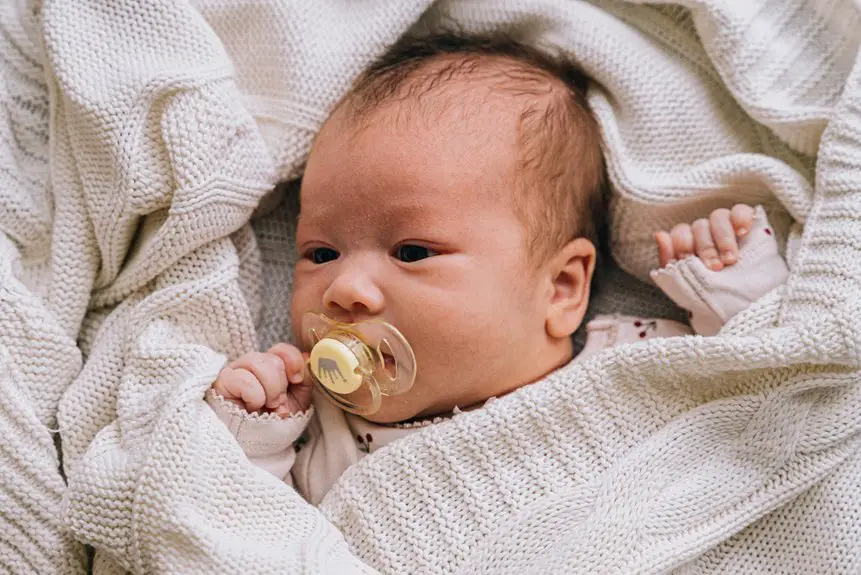You might think any baby blanket will do, but choosing the wrong fabric could mean endless irritation for your little one. When you want truly hypoallergenic options, you need to look beyond just softness and style. There are key materials that stand out because of how they interact with sensitive skin and allergens. Understanding these can make all the difference in your baby’s comfort and safety—so let’s explore which fabrics really deliver on that promise.
Table of Contents
Key Takeaways
- Organic cotton is a top hypoallergenic fabric, grown without harmful chemicals and offering soft, breathable comfort for sensitive baby skin.
- Bamboo fabric naturally resists allergens, is moisture-wicking, breathable, and gentle, making it ideal for hypoallergenic baby blankets.
- Avoid synthetic fibers and harsh chemical treatments, as they can trigger allergies and irritate delicate skin.
- Hypoallergenic blankets should be free from dyes, fragrances, and toxic substances to minimize allergic reactions.
- Breathable, soft textures that regulate temperature and wick moisture support comfort and reduce skin irritation risks.
Understanding Hypoallergenic Fabrics for Babies
Although choosing the right fabric can feel overwhelming, understanding hypoallergenic materials helps you protect your baby’s sensitive skin.
When selecting a baby blanket, you should look for fabrics with hypoallergenic certifications—they guarantee the material has been tested to minimize allergic reactions. Pay close attention to fabric composition; natural fibers like organic cotton and bamboo are often better tolerated than synthetic ones.
These natural fabrics tend to be breathable and gentle, reducing irritation risks. Avoid materials treated with harsh chemicals or dyes, as they can trigger allergies.
Benefits of Using Hypoallergenic Baby Blanket Materials
When you choose hypoallergenic baby blanket materials, you reduce the risk of skin irritation and allergic reactions, keeping your baby comfortable and safe.
Choosing hypoallergenic baby blankets helps prevent skin irritation and allergies, ensuring your baby’s comfort and safety.
These fabrics promote better baby health by minimizing exposure to common allergens like dust mites, mold, and harsh chemicals often found in conventional textiles.
Hypoallergenic materials guarantee fabric safety by being free from dyes, fragrances, and toxic substances, which can trigger sensitivities in delicate skin.
Using such blankets supports your baby’s immune system and helps prevent rashes or respiratory issues linked to allergens.
Plus, hypoallergenic fabrics often offer breathability and softness, enhancing comfort while maintaining a protective barrier.
Why Organic Cotton Is a Top Choice for Baby Blankets
You want your baby’s blanket to be free from harsh chemicals, and organic cotton delivers just that.
It’s incredibly soft and breathable, keeping your little one comfortable all day long.
Choosing organic cotton means you’re giving your baby gentle care without compromising on quality.
Chemical-Free Comfort
Choosing organic cotton for your baby blanket means opting for a fabric grown without harmful chemicals or pesticides. This guarantees your little one’s skin isn’t exposed to irritants that can cause allergies or discomfort.
Organic cotton also supports fiber sourcing ethics, so you can trust that the material comes from farms prioritizing environmental sustainability and fair labor practices.
Beyond growth, many organic cotton blankets use natural dyeing techniques, avoiding synthetic dyes known to trigger sensitivities. These processes maintain the fabric’s purity and reduce chemical residues that might harm your baby’s delicate skin.
Softness and Breathability
Softness and breathability play vital roles in keeping your baby comfortable throughout the day and night. When you choose organic cotton, you get a fabric with a naturally soft texture that feels gentle against sensitive skin. Breathable materials like organic cotton allow air to circulate, reducing the risk of overheating and keeping your baby cozy without sweating. This balance is essential for a peaceful sleep and happy days.
| Feature | Benefit |
|---|---|
| Soft Texture | Prevents skin irritation |
| Breathable Materials | Regulates temperature |
| Organic & Chemical-Free | Guarantees hypoallergenic comfort |
Exploring Bamboo Fabric for Sensitive Baby Skin
If your baby has sensitive skin, bamboo fabric might be just what you need since it’s naturally soft, breathable, and hypoallergenic.
You’ll appreciate how it helps reduce irritation while keeping your little one cozy.
Just remember to follow gentle care tips to keep the fabric in great shape.
Bamboo Fabric Benefits
Because bamboo fabric naturally resists allergens and moisture, it’s an excellent choice for babies with sensitive skin. You’ll appreciate how bamboo softness feels gentle against delicate skin, reducing irritation risks.
Beyond comfort, bamboo sustainability makes it an eco-friendly option, as bamboo grows quickly without pesticides or excessive water. This means you’re choosing a fabric that’s kind to both your baby and the planet.
Plus, bamboo’s breathability helps regulate temperature, keeping your little one cozy without overheating. When you pick bamboo blankets, you combine natural hypoallergenic properties with durability and softness that improves with each wash.
Skin Sensitivity Compatibility
When your baby has sensitive skin, choosing the right fabric is essential to prevent irritation and discomfort. Bamboo fabric stands out because it naturally minimizes skin irritation and reduces common allergy triggers. Its smooth texture feels gentle, soothing your baby’s delicate skin.
You’ll appreciate that bamboo is breathable and moisture-wicking, which further protects sensitive skin from rashes.
Here’s why bamboo fabric works well for sensitive skin:
- Hypoallergenic properties reduce allergy triggers
- Soft, smooth fibers prevent friction-related irritation
- Breathability helps regulate temperature and moisture
- Naturally antimicrobial, limiting bacteria buildup
Care Tips for Bamboo
Choosing bamboo fabric for your baby’s sensitive skin means you’ll want to handle it with care to maintain its softness and hypoallergenic benefits.
For effective bamboo care, always wash the blanket in cold water using a gentle detergent free of dyes and fragrances. Avoid bleach or fabric softeners, as they can damage the fibers and reduce the fabric’s natural breathability.
When drying, choose a low heat setting or air dry to prevent shrinking and preserve the bamboo’s texture.
Bamboo maintenance also includes storing the blanket in a dry, well-ventilated area to prevent mildew.
Comparing Wool and Other Natural Fibers for Baby Blankets
Although wool is a popular choice for baby blankets due to its warmth and natural moisture-wicking properties, you might wonder how it stacks up against other natural fibers like cotton, bamboo, or alpaca.
Each fiber offers unique benefits and challenges, especially when considering hypoallergenic qualities and comfort.
- Wool properties include excellent insulation and breathability but can sometimes irritate sensitive skin.
- Cotton is soft, breathable, and widely hypoallergenic, making it a safe bet for many babies.
- Bamboo fibers are naturally antimicrobial and moisture-wicking, ideal for sensitive skin.
- Alpaca is hypoallergenic and silky soft, but less common and sometimes pricier.
The Role of Tencel Modal in Hypoallergenic Baby Bedding
Since you want the softest and safest fabric for your baby’s skin, Tencel modal deserves your attention.
For the softest, safest fabric for your baby’s delicate skin, consider Tencel modal.
This fabric, made from sustainably sourced wood pulp, offers exceptional Tencel benefits like breathability and moisture-wicking, keeping your baby comfortable and dry.
Its smooth texture reduces irritation, making it ideal for sensitive skin. You’ll also appreciate Tencel durability—it holds up well to frequent washing without losing softness or shape.
Unlike some natural fibers, Tencel resists bacteria growth naturally, enhancing its hypoallergenic qualities.
Choosing baby bedding with Tencel modal means you’re opting for a fabric that balances softness, safety, and strength, ensuring your little one rests peacefully while you enjoy easy care and long-lasting quality.
Factors to Consider When Choosing Hypoallergenic Baby Blanket Fabrics
When selecting hypoallergenic baby blanket fabrics, you’ll want to focus on several key factors that guarantee both comfort and safety.
Choosing materials that minimize allergy triggers is crucial to protect your baby’s sensitive skin. You should also consider fabric durability to make certain the blanket withstands frequent washing without losing its softness or protective qualities.
Additionally, pay attention to breathability and softness, as these greatly affect your baby’s comfort.
- Minimize allergy triggers by avoiding harsh chemicals and synthetic fibers
- Prioritize fabric durability for long-lasting use
- Choose breathable materials to regulate temperature
- Select soft textures to prevent skin irritation
Frequently Asked Questions
How Do Hypoallergenic Fabrics Affect Babies With Eczema?
If your baby has eczema, hypoallergenic fabrics reduce eczema triggers by minimizing irritants. You’ll find these gentle materials help protect sensitive skin, preventing flare-ups and keeping your little one comfortable and rash-free during sleep or playtime.
Are Hypoallergenic Baby Blankets Safe for Newborns?
Isn’t your newborn’s safety your top priority? You’ll find hypoallergenic baby blankets made from gentle fabric types like organic cotton or bamboo are safe, reducing irritation risks and ensuring comfort for your precious little one.
Can Hypoallergenic Fabrics Prevent Dust Mite Allergies?
You can reduce dust mite allergy risks by choosing hypoallergenic fabrics for your baby’s blanket. These materials resist dust mite buildup, aiding allergy prevention and keeping your little one more comfortable and protected from irritants.
How Often Should Hypoallergenic Baby Blankets Be Washed?
Remember, “cleanliness is next to godliness.” You should maintain a regular washing frequency for your hypoallergenic baby blanket, typically once a week, to guarantee ideal fabric care and keep allergens at bay.
Do Hypoallergenic Fabrics Reduce the Risk of Overheating?
You’ll find breathable materials in hypoallergenic fabrics help with temperature regulation, reducing overheating risks. They let air flow, keeping your baby comfortable and cool, especially during sleep or warmer weather.
- Why Do My Linen Clothes Sometimes Develop Pills? - June 11, 2025
- How to Remove Pilling From Chenille Fabric Without Snagging It? - June 11, 2025
- What’s the Best Way to Store Clothes to Minimize Pilling Risks? - June 11, 2025






